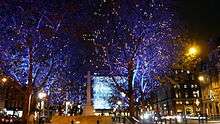Sloane Square



Sloane Square is a small hard-landscaped square on the boundaries of the central London[1] districts of Knightsbridge, Belgravia and Chelsea, located 2.1 miles (3.4 km) southwest of Charing Cross, in the Royal Borough of Kensington and Chelsea. The area forms a boundary between the two largest aristocratic estates in London, the Grosvenor Estate and the Cadogan. The square was formerly known as 'Hans Town', laid out in 1771 to a plan of by Henry Holland Snr. and Henry Holland Jnr. Both the square and Hans Town were named after Sir Hans Sloane (1660–1753), whose estates owned the land at the time.[2]
Location
The square lies at the east end of Kings Road and at the south end of the more conventionally smart Sloane Street linking to Knightsbridge. In the early 1980s, it lent its name to the "Sloane Rangers", the young underemployed, often snooty and ostentatiously well-off members of the upper classes. On the northern side of the square is the Sloane Square Hotel.
History
The square has two notable buildings. Peter Jones department store designed by Reginald Uren of the firm Slater Moberly and Uren in 1936 and now a Grade II* listed building on account of its early curtain wall and modernist aesthetic, pioneering in the UK for a department store.[3] The building was carefully restored 2003-2007 with internal upgrading in line with the original designs by John McAslan and Partners. This included making the three storey atrium full-height.[4] Peter Jones now operates as part of the employee-owned John Lewis chain.
The other is the Royal Court Theatre first opened in 1888 which was important for avant-garde theatre in the 1960s and 1970s when the home of the English Stage Company.[5]
100m from the Square in Sloane Terrace, the former Christian Science Church[6] was built in 1907 and converted in 2002 for concert hall use as Cadogan Hall. It is now one of London's leading classical music venues.[7]
In 2005 revised landscaping of the square was proposed, involving a change to the road layout to make it more pedestrian friendly. One option was to create a central crossroads and two open spaces in front of Peter Jones and the Royal Court. The pedestrian area leading to Pavilion Road now houses the flagship stores of many luxury brands including Brora and Links of London. This option was put out to consultation, and the results in April 2007 showed that over 65% of respondents preferred a renovation of the existing square, so the crossroads plan has been shelved. Since then, independent proposals[8] have been put forward for the square.
A short walk down Kings Road from the Square is the National Army Museum.
Holy Trinity Sloane Street, the Church of England parish church of 1890 (50m north of the Square) is sometimes known as the "Cathedral of the Arts & Crafts Movement on account of its fine fittings. These include a complete set of windows by Sir Edward Burne-Jones, the most extensive he ever created.
Sloane Square Underground station (District and Circle lines) is at the south eastern corner of the square and the lines cross under the square to the north west. The River Westbourne is carried over the tube station platforms in plain view, in a circular iron aqueduct.
Fountain
The Venus Fountain in the centre of the square was constructed in 1953, designed by sculptor Gilbert Ledward.[9][10] The fountain depicts Venus, and on the basin section of the fountain is a relief which depicts King Charles II and Nell Gwynn by the Thames,[10] which was used in relation to a house located close by that Nell Gwynn had used.[9]
In 2006, David Lammy put forward a proposal to have the fountain grade II listed,[9] which was successful.[10]
Popular culture
This square is mentioned by Morrissey in his song "Hairdresser on Fire", which was a B-side on his 1988 "Suedehead" single.
In the Doctor Who film Daleks – Invasion Earth: 2150 A.D., the Dalek spaceship lands in Sloane Square amidst the ruins of 22nd century London.
Sloane Square is mentioned by Owen in the third track "Love is Not Enough" on L'Ami du Peuple.
See also
References
- ↑ "London's Places" (PDF). London Plan. Greater London Authority. 2011. p. 46. Retrieved 27 May 2014.
- ↑ British History Online: British-history.ac.uk; 2004
- ↑ https://historicengland.org.uk/listing/the-list/list-entry/1226626
- ↑ http://www.building.co.uk/keeping-up-at-peter-jones/3084637.article
- ↑ https://historicengland.org.uk/listing/the-list/list-entry/1226628
- ↑ https://historicengland.org.uk/listing/the-list/list-entry/1226700
- ↑ Cadogan Hall
- ↑ Richardbird.info, Independent proposal for improvement
- 1 2 3 Culture.gov.uk 'Proposal for Listing of Venus Fountain'
- 1 2 3 'Fountains of London' - Secret London
External links
| Wikimedia Commons has media related to Sloane Square. |
Coordinates: 51°29′33″N 0°09′26″W / 51.492521°N 0.157188°W
